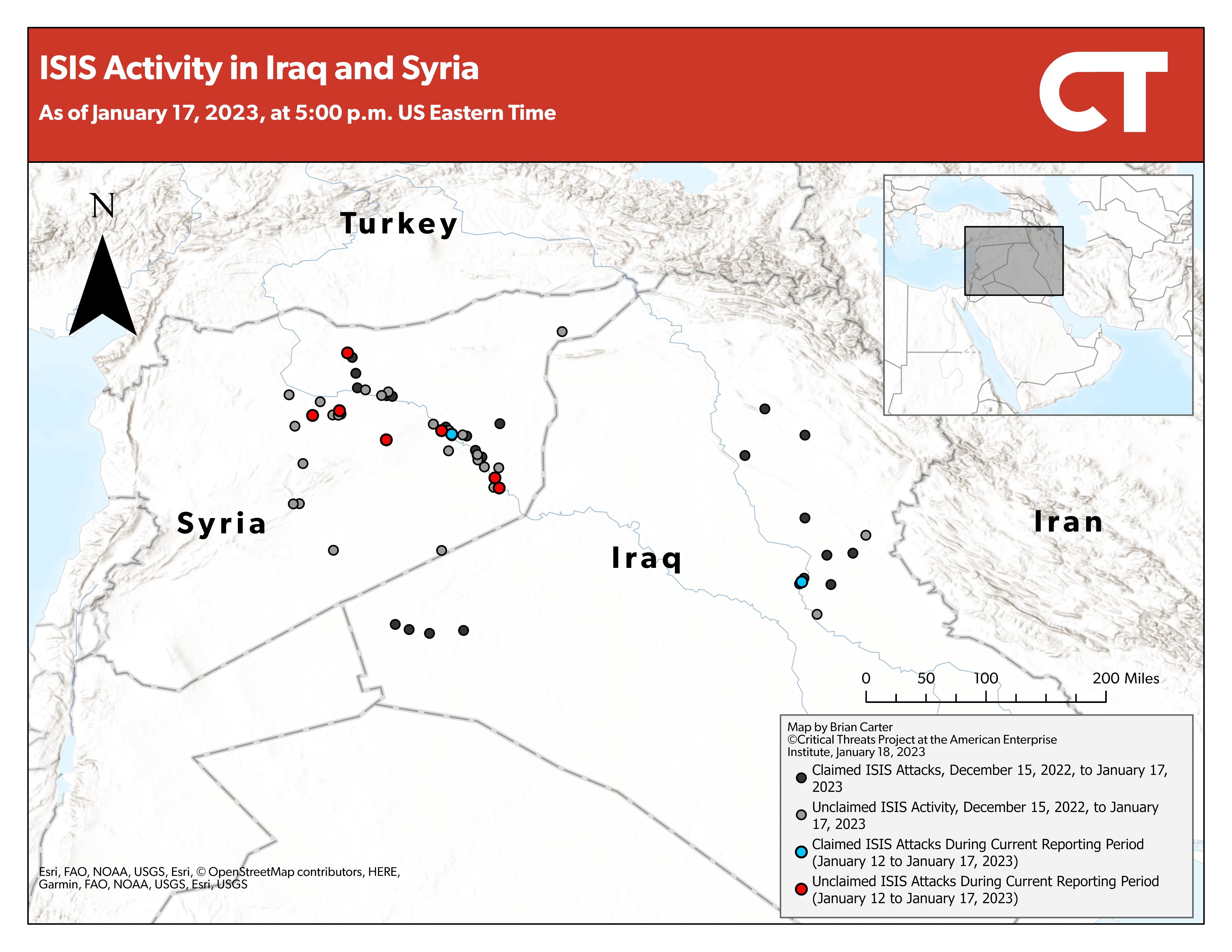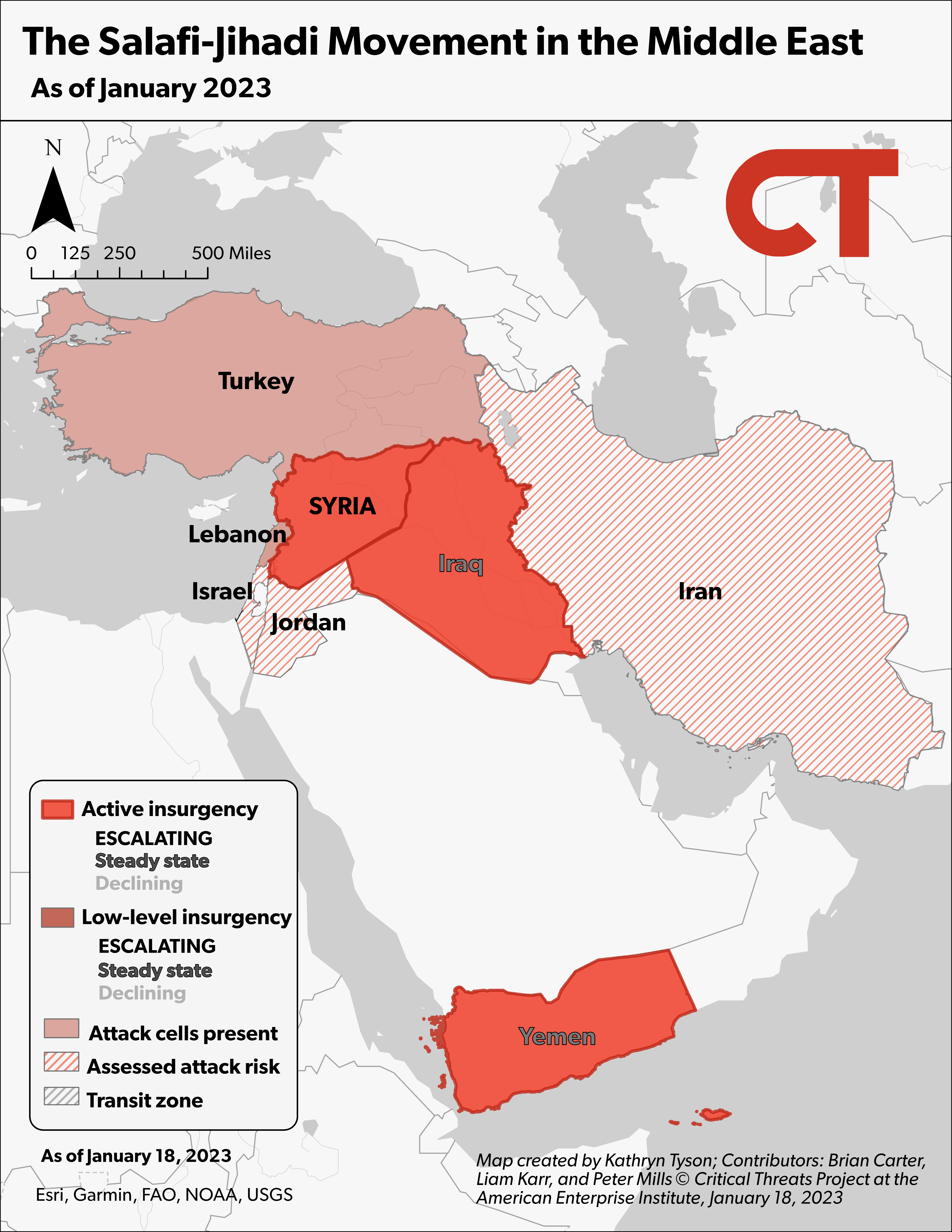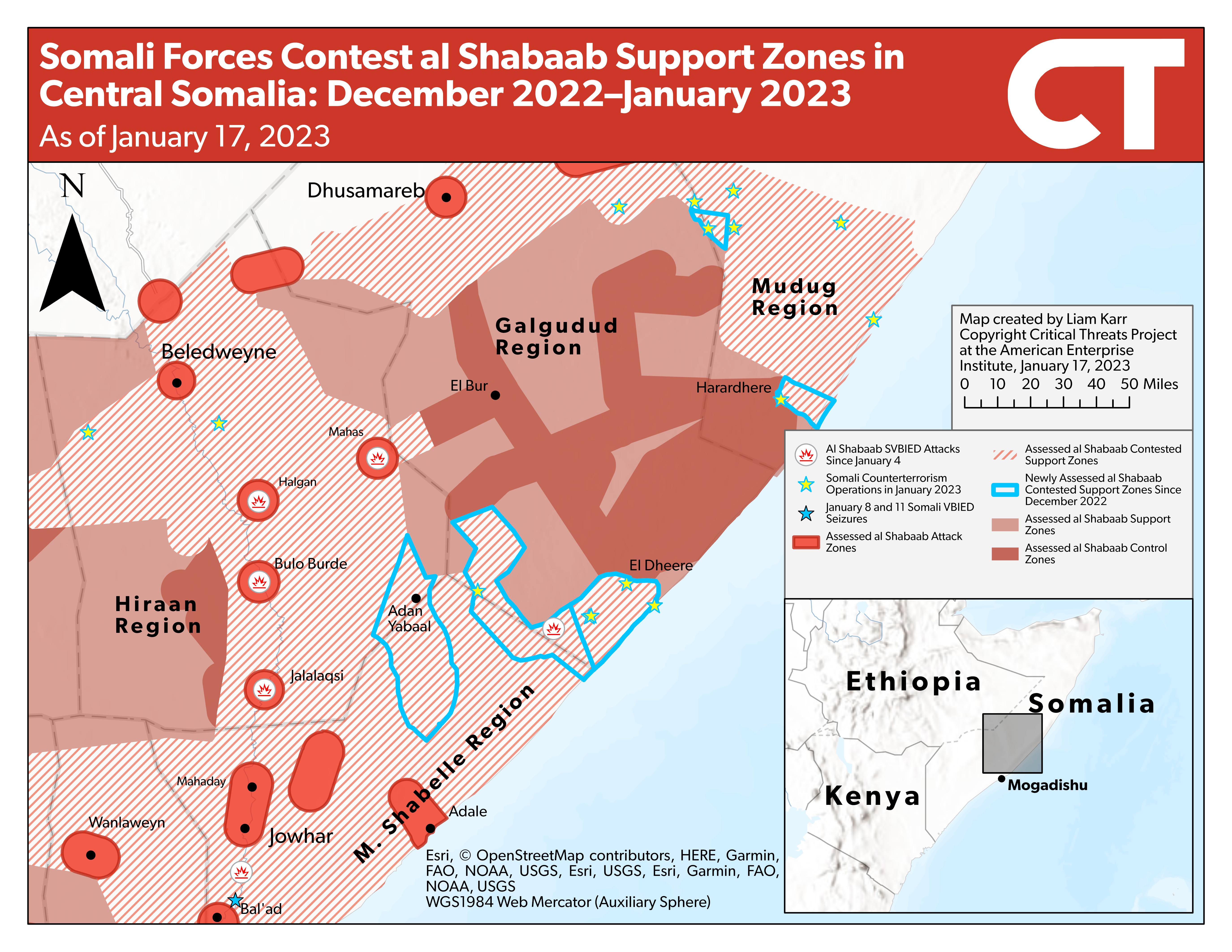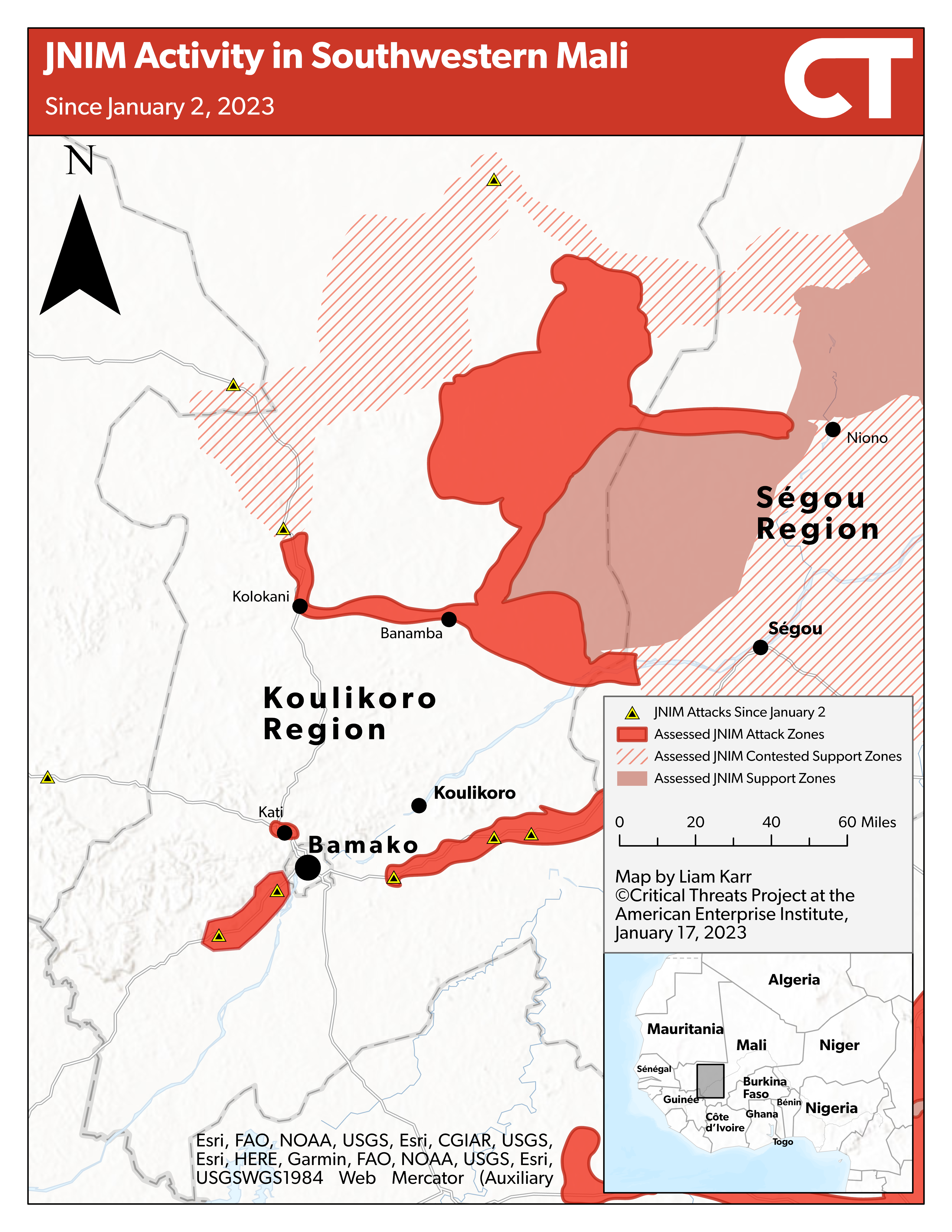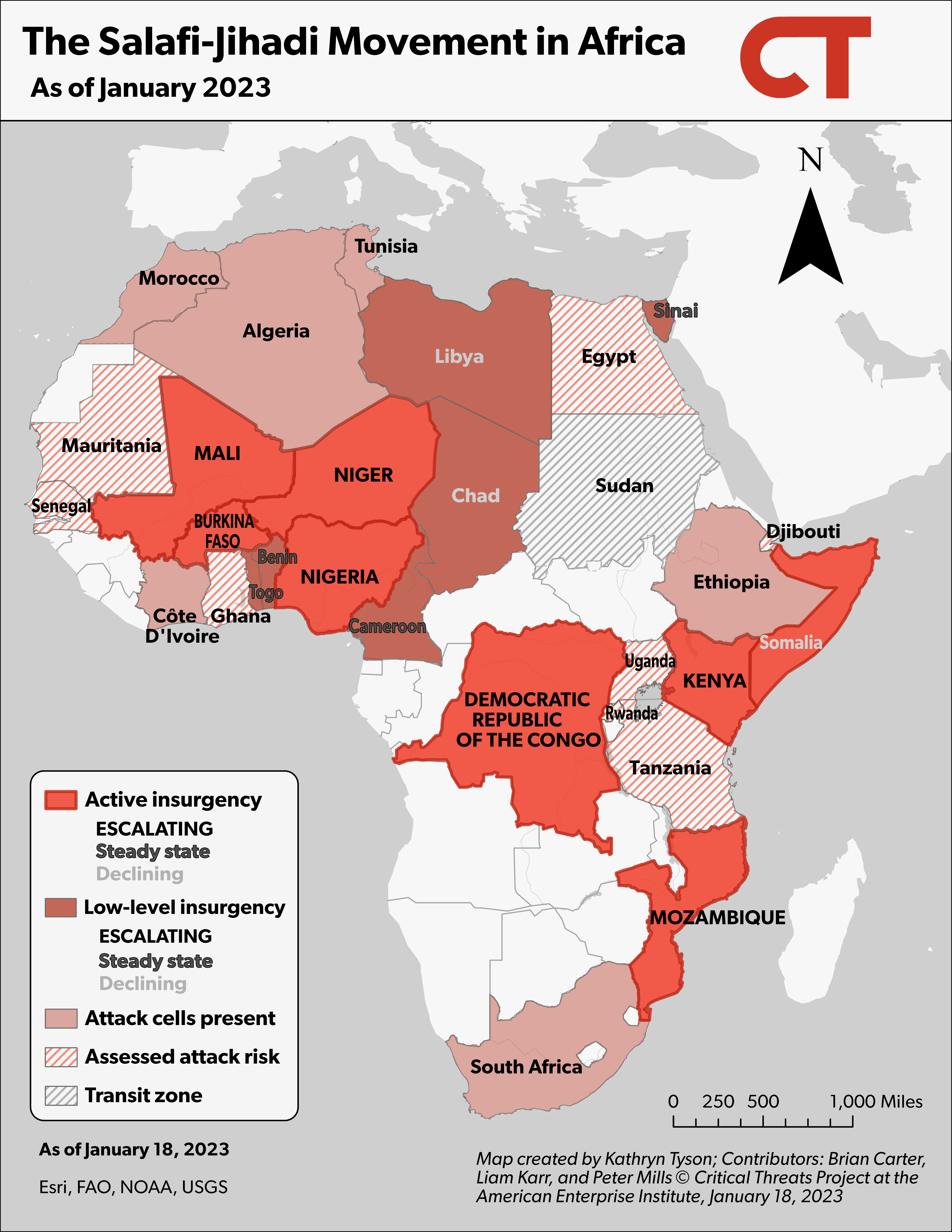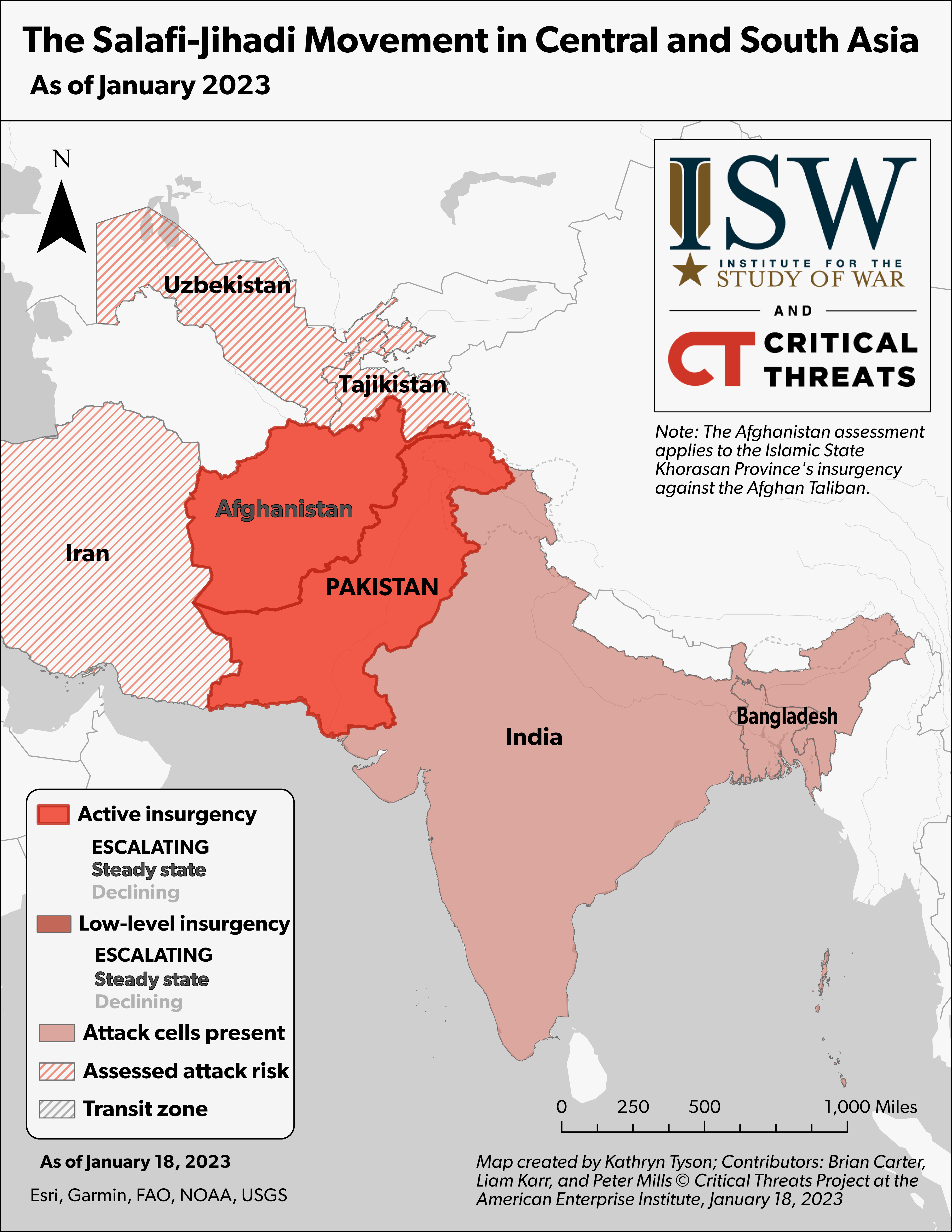Authors: Brian Carter, Kathryn Tyson, Liam Karr, and Peter Mills
Data Cutoff: January 18, 2023 at 10 a.m.
Key Takeaways:
Syria. A potential Turkish military operation into northern Syria could draw the Syrian Democratic Forces (SDF) away from counter-ISIS efforts. The SDF commander is warning of an imminent Turkish incursion. Even a limited Turkish invasion would drain SDF resources and likely allow ISIS to accelerate its efforts to erode and replace SDF governance structures in eastern Syria.
Somalia. Anti–al Shabaab forces notched a significant victory in an ongoing offensive in central Somalia by capturing two logistical and financial hubs from al Shabaab. Al Shabaab has stepped up suicide attacks in response to the offensive, but its loss of these locations may harm its ability to sustain a counterattack over time. Al Shabaab’s withdrawal from the captured towns likely indicates that it withdrew in preparation for a future counterattack, though there are also limited indicators that the group is losing bandwidth and morale.
Mali. Al Qaeda’s Sahel branch increased attacks near the Malian capital in a likely effort to undermine the legitimacy of the Malian junta, which has promised to increase security in the country. The uptick in attacks indicates that Salafi-jihadi militants likely have access to enduring havens in southwestern Mali, signaling a shift in the militants’ ability to threaten Mali’s government and largest city.
Afghanistan. The Taliban government is conducting information operations to deflect blame for ongoing security failures. Taliban security measures have failed to prevent assassinations and Islamic State Khorasan Province (ISKP) attacks in major cities. A leaked Taliban Ministry of Defense document blamed Pakistan for the infiltration of ISKP fighters into Afghanistan. Poorly resourced Taliban border security forces will struggle to control the Afghan-Pakistan border and prevent ISKP cross-border movement.
Assessments:
Syria. A potential Turkish incursion in northern Syria risks drawing the SDF away from its already strained efforts to counter ISIS in eastern Syria.
A Turkish incursion is possible but not certain. Turkey seeks to build a protective “security corridor” in northern Syria to protect against the SDF, which they view as a cover for the US-designated terror organization Kurdistan Workers’ Party (PKK). The SDF’s commander said he expected a Turkish incursion near Kobani in Aleppo province in February, while Turkey said it could launch an incursion “at any time.”[1] Turkey began air strikes against the SDF and hinted it might invade SDF-controlled Syria in November 2022. Russian opposition likely prevented the operation.[2] Turkey and the SDF could both be posturing by emphasizing the threat of an invasion, and Turkey is currently engaged in normalization talks with Syria facilitated by Russia.[3] Both Syria and Russia oppose a Turkish incursion.[4] This diplomatic context means that a limited Turkish air or artillery effort against the SDF is more likely than a ground incursion, though both remain possible.
Even a limited Turkish operation, whether a ground incursion targeting Kobani or air effort targeting SDF positions in northern Syria, would undermine SDF counterterrorism operations against ISIS. The SDF paused counter-ISIS operations with the US-led counter-ISIS coalition when Turkey threatened to invade in November 2022.[5] Turkish air strikes targeting SDF military positions would pin the SDF in place, allowing ISIS to move more freely in certain areas of northeastern Syria. The SDF would likely significantly draw down its presence in some areas of Deir Ezzor province in eastern Syria in the event of an incursion. ISIS would likely capitalize on the SDF’s focus on Turkish military activity to increase its activities in Deir Ezzor. ISIS is already attempting to erode the SDF presence in Deir Ezzor by targeting SDF patrols and assassinating pro-SDF officials, causing the SDF to decrease its presence in certain areas.
For more on ISIS activity in Deir Ezzor, see Brian Carter’s “ISIS Will Leverage Improved Attack Capabilities to Generate Forces in Syria.”[6]
Figure 1. ISIS Activity in Iraq and Syria
Source: Brian Carter.
Note: CTP defines “attacks” as kinetic activity, including assassinations, armed assaults on military positions, executions, and bombings. “Activity” includes all forms of ISIS activity, including attacks, force movements, and reports of governance activity like zakat collection. ISIS does not generally report on these non-kinetic activities and does not claim all of its attacks.
Figure 2. The Salafi-Jihadi Movement in the Middle East
Source: Kathryn Tyson.
Somalia. Anti–al Shabaab forces increased pressure on al Shabaab in central Somalia by capturing district capitals that al Shabaab has used for logistics and finances. The current offensive, which began in summer 2020, is the first Somali-led offensive against al Shabaab and the largest challenge to al Shabaab’s presence in central Somalia since 2015. Somali forces and local clan militias, with US and Turkish drone support, cleared al Shabaab from its former strongholds in eastern Hiraan region in central Somalia in September 2022. They also cleared the Middle Shabelle region from October to December and began clearing operations in the Galgudud and Mudug regions in late December and early January.[7]
Anti–al Shabaab forces, including US-trained special forces, captured two district capitals—Harardhere and El Dheere—in north-central Somalia on January 16 and 17.[8] These takeovers mark an important symbolic and military victory for anti–al Shabaab forces, which had been unable to enter Harardhere since al Shabaab took over the town in 2008.[9] The capture of Harardhere and El Dheere also eliminates al Shabaab’s two largest ports on the central Somalia coast, cutting key supply and smuggling lines that supply the group’s activities in central Somalia.[10]
Al Shabaab is weathering the offensive by retreating and regrouping to launch counterattacks from rural areas. It used these rear staging areas to launch a wave of suicide vehicle-borne improvised explosive device (SVBIED) attacks in the Hiraan and Middle Shabelle regions beginning in early January.[11] The group has carried out at least six SVBIED attacks in the Middle Shabelle and Hiraan regions since January 4, using at least 12 vehicle borne improvised explosive devices (VBIED) across the attacks.[12] Somali security forces also seized four unused VBIEDs in Middle Shabelle region on January 8 and 11.[13] Al Shabaab will likely use this same retreat-and-counterattack strategy in north-central Somalia. The group’s fighters withdrew from Harardhere and El Dheere before security forces arrived.[14] The Somali Federal Government is seeking to rebuff the coming counterattacks by garrisoning major towns and using local militias to target al Shabaab staging areas.[15] Somali forces have thus far repelled two large-scale al Shabaab suicide raids on its positions in central Somalia in January.[16]
The rapid fall of Harardhere could alternatively indicate that al Shabaab forces in central Somalia are overstretched and lacking morale. Anti–al Shabaab forces quickly captured Harardhere, taking over the district capital only 10 days after beginning operations in Mudug.[17] Al Shabaab also has not yet attacked anti–al Shabaab forces in Mudug. This relatively quiet response is noteworthy because al Shabaab appears to be ceding more valuable terrain with less resistance compared to earlier in the campaign.[18] Furthermore, two al Shabaab factions reportedly clashed north of Harardhere on December 31, killing 12 militants, after one group attempted to defect.[19] These factors indicate that al Shabaab forces may have been unable or unwilling to launch a meaningful defense in north-central Somalia. The group remains likely to marshal a counteroffensive in the future, however, and retains significant strategic depth in Somalia.
Figure 3. Somali Forces Contest al Shabaab Support Zones in Central Somalia: December 2022–January 2023
Source: Liam Karr.
Mali. Al Qaeda–linked militants launched a rare offensive in southwestern Mali near the country’s capital. Salafi-jihadi groups have operated in northern Mali since 2012 and have been active in central and southern Mali since at least 2015, when militants connected to al Qaeda–linked Ansar al Din created a subgroup called the Macina Liberation Front (MLF).[20] The MLF is a component of Jama’a Nusrat al Islam wa al Muslimeen (JNIM), al Qaeda’s main branch in the Sahel that formed from a merger of several Salafi-jihadi groups in 2017. The MLF operates in central Mali, where it has embedded itself by capitalizing on ethnicity-based intercommunal conflict and security force abuses.[21]
JNIM fighters, likely from MLF, have increased attacks in southwestern Mali since early January 2023. This uptick follows a gradual increase in activity since summer 2022.[22] The group has attacked in Koulikoro—the region surrounding Mali’s capital Bamako—at least six times since January 2.[23] Many of these attacks targeted towns along the main roads running into Bamako, including two attacks in the Kayes region west of Koulikoro. This pattern indicates a concerted effort to disrupt lines of communication between Bamako and the rest of southwestern Mali.[24] The attacks mark a sharp increase in JNIM activity in southwestern Mali. JNIM only attacked in the Koulikoro region once between September and December 2022.[25] JNIM has also organized attack cells in Bamako and threatened to attack the capital in recent years, though it has not conducted any major terror attacks there since 2015.[26]
Figure 4. JNIM Activity in Southwestern Mali
Source: Liam Karr.
The January attacks occurred unusually close to Bamako and may indicate JNIM has established havens in northeastern Koulikoro. The MLF entered the Koulikoro region in 2018 and has concentrated much of its previous activity in the Banamba Cercle in northeastern Koulikoro.[27] None of the attacks in 2023 have occurred in Banamba, while several have been in the same administrative cercle as Bamako, including one just four miles from the Bamako city limits.[28] This shift likely indicates that the group has established havens in Banamba that it is using to expand further southwest. JNIM could move through areas of Banamba relatively unchallenged in early 2022; militants closed several schools before Malian forces claimed to remove them from the area.[29] The attacks also show JNIM is continuing to establish itself around the capital following a previous small offensive in July 2022 that included a suicide attack targeting the Malian army base in Kati.[30]
Continued JNIM attacks in politically sensitive areas of southwestern Mali will challenge the junta’s legitimacy. The junta rose to power in 2021 following two coups in as many years. The coups followed months of nonviolent protests demanding the Malian president’s resignation due to corruption and instability stemming from the Salafi-jihadi insurgency and other security challenges.[31] JNIM has explicitly framed its attacks as a direct challenge to the junta’s authority. The group highlighted its increased activity in southwestern Mali as a sign that the Malian government is lying about containing JNIM.[32] JNIM called attacks on January 2 a “New Year’s gift” to the Malian government and threatened to continue attacks until the government stopped “oppressing Muslims.”[33] Attacks in Kati specifically undermine the junta because the Kati base is the symbolic birthplace of the 2020 coup that helped bring the junta to power.[34]
Figure 5. The Salafi-Jihadi Movement in Africa
Source: Kathryn Tyson.
Afghanistan. The Taliban government is attempting to compensate for continuing security failures by controlling Afghanistan’s information environment. These failures include the murder of a former member of parliament (MP), whom the Taliban claimed it sought to protect, and regular ISKP attacks and cross-border movements.
The Taliban government routinely suppresses media reporting on killings in Afghanistan. It likely failed to suppress reporting on the January 15 killing of former female MP Mursal Nabizada in Kabul, which many international media outlets covered.[35] Taliban officials and Taliban state media responded by promoting an interview with Nabizada’s mother in which she claimed the Taliban government closely coordinated with the family regarding security.[36] The killing of people associated with the former Afghan Republic is not unusual, but the death of a female politician following recent Taliban restrictions on women’s rights further harms its position in the international community while also underscoring the Taliban’s inability to guarantee security in Afghanistan. ISKP may be responsible for Nabizada’s killing but has not claimed responsibility.
The Taliban government likely also seeks to blame Pakistan for ISKP attacks in Afghanistan. A leaked Taliban Ministry of Defense document accused Pakistan of facilitating the infiltration of ISKP fighters into Afghanistan.[37] The leaked memo estimated a concentration of ISKP fighters several times larger than ISKP’s likely actual size.[38] ISKP operates and conducts attacks inside Pakistan, including near the border with Afghanistan, but it is highly unlikely it has amassed such a large force inside one valley in Pakistan. The same Taliban unit responsible for the leaked memo also recently complained about a lack of supplies, including a lack of food and spare parts to maintain its vehicles.[39] The leaked memo may have exaggerated the ISKP threat to cajole more resources from the Taliban Ministry of Defense.
The Taliban government continues to struggle to adequately resource its military units, including units responsible for border security with Pakistan. Pakistani officials recently warned that the Taliban’s financial difficulties could lead to some Taliban factions defecting and joining ISKP.[40] ISKP’s willingness to pay higher salaries has previously attracted defectors from other Salafi-jihadi groups in Afghanistan.[41]
Figure 6. The Salafi-Jihadi Movement in Central and South Asia
Source: Kathryn Tyson.
Other Updates:
Middle East
Iraq: Iraqi Prime Minister Mohammed al Sudani voiced support for a continued US military presence in Iraq. Sudani said on January 15 that Iraq needs a continued US presence to defeat ISIS.[42] US forces based in Iraq also enable the counter-ISIS mission in Syria and NATO Mission in Iraq.[43] The US military also provides operationally valuable advising to some Iraqi military forces.[44]
Yemen: Al Qaeda in the Arabian Peninsula leader Khaled al Batarfi called on Yemenis to “rise” against Israel, Saudi Arabia, the United Arab Emirates (UAE), the United States, and Houthis in Yemen to prevent Yemen from becoming like Afghanistan and Iraq.[45] Batarfi accused Saudi Arabia and the UAE of permitting US and Israeli military operations.
Africa
Burkina Faso: Likely Salafi-jihadi militants abducted at least 50 women from a rural area in northeastern Burkina Faso on January 12 and 13.[46] JNIM and the Islamic State Greater Sahara Province are both active in this region.
Democratic Republic of the Congo: Islamic State Central Africa Province, also known as the Allied Democratic Forces (ISCAP-ADF), bombed a church in Beni territory, North Kivu region, on January 15.[47] The attack killed at least 17 people and wounded 29 others. Security forces arrested a Kenyan citizen from northeastern Kenya in connection with the attack.[48] ISCAP-ADF’s attack claims emphasized that security forces could not protect Christians.[49]
Central and South Asia
Afghanistan: The former director of the Afghan Republic’s intelligence services, Rahmatullah Nabil, announced the creation of a new anti-Taliban political party called the Afghanistan National Liberation Party (ANLP).[50] Nabil is a Pashtun, originally from Wardak Province, who commanded former Afghan President Hamid Karzai’s presidential guard and led the National Directorate of Security from 2010 to 2015.[51] The ANLP’s charter states it will pursue a democratic decentralized Afghanistan. The ANLP's charter does not currently call for armed resistance to the Taliban government but warns that Afghanistan is on the brink of renewed civil war unless the Taliban government makes drastic changes to its policies.
Pakistan: The Tehrik-e-Taliban Pakistan (TTP) continued to escalate an attack campaign against the Pakistan government following the TTP’s ending of a cease-fire in November 2022. Nine TTP militants attacked a police checkpoint and killed two policemen in Taunsa, Punjab Province, central Pakistan, on January 13.[52] The TTP relatively rarely conducts attacks in Punjab and only attacked five times in the region in 2022.[53] The Punjab chief of police ordered increased security measures against the TTP in Punjab and improved security coordination with neighboring regions in response to the attack.[54] The TTP’s escalating campaign will pressure Pakistan to consider renewed military efforts against the TTP. Pakistan is considering strikes against the TTP in Afghanistan, a move that will further worsen relations between the Pakistan government and the Afghan Taliban government. The TTP has havens in Afghanistan and long-standing ties to the Afghan Taliban.[55]
[1] https://www.france24.com/en/middle-east/20230114-turkish-officials-say-offensive-in-syria-possible-at-any-time; https://www.al-monitor.com/originals/2023/01/syrian-kurdish-commander-wants-peace-turkey-will-fully-resist-attack#ixzz7qa7M6DVf
[2] https://warontherocks.com/2022/12/turkeys-russian-red-light-in-syria; https://www.arcgis.com/apps/instant/basic/index.html?appid=10a67dbd3ad54185a1149328903f5474
[3] https://www.axios.com/2022/12/21/erdogan-assad-rapprochement-syria-turkey; https://www.middleeasteye dot net/news/turkey-syria-meeting-no-deals-made-first-high-level-talks
[4] https://warontherocks.com/2022/12/turkeys-russian-red-light-in-syria; https://www.axios.com/2022/12/21/erdogan-assad-rapprochement-syria-turkey; https://www.reuters.com/world/middle-east/syrian-foreign-minister-no-normal-ties-with-turkey-without-end-occupation-2023-01-14; https://www.dailysabah dot com/politics/diplomacy/terrorist-groups-not-turkish-presence-a-threat-to-syria-official
[5] https://twitter.com/farhad_shami/status/1595488304425844742?s=20&t=z_RbPD4Lligtg3YFHdhmwA
[6] https://www.criticalthreats.org/analysis/isis-will-leverage-improved-attack-capabilities-to-generate-forces-in-syria
[7] https://twitter.com/criticalthreats/status/1600503178247692288?s=20&t=2LGkBMsQvHkpbICpm1UhYQ; https://www.criticalthreats.org/briefs/gulf-of-aden-security-review/gulf-of-aden-security-review-january-4-2023
[8] https://www.criticalthreats.org/briefs/gulf-of-aden-security-review/gulf-of-aden-security-review-january-18-2023
[9] https://www.cnn.com/2018/10/16/politics/us-somalia-airstrike-al-qaeda/index.html; https://www.theguardian.com/world/2019/jan/20/dozens-of-al-shabaab-fighters-killed-in-us-airstrike-says-military
[10] https://hiraalinstitute dot so/wp-content/uploads/2022/02/Al-Shabaabs-Arsenal-From-Taxes-to-Terror-Web.pdf
[11] https://www.criticalthreats.org/analysis/salafi-jihadi-movement-weekly-update-january-12-2023
[12] https://www.criticalthreats.org/briefs/gulf-of-aden-security-review/gulf-of-aden-security-review-january-18-2023
[13] https://www.criticalthreats.org/briefs/gulf-of-aden-security-review/gulf-of-aden-security-review-january-9-2023; https://twitter.com/RadioMuqdisho/status/1613224197500862464
[14] https://www.caasimada dot net/xog-kooxda-al-shabaab-oo-amar-culus-ku-soo-rogtay-dadka-ku-nool-ceeldheer; http://www.hiiraan dot com/news4/2023/Jan/189491/al_shabab_withdrew_from_haradhere_district_in_mudug_region.aspx
[15] https://www.caasimada dot net/daawo-gen-biixi-oo-reer-aadan-yabaal-ka-codsaday-inay-ciidanka-df-gabdhahooda-u-guuriyaan-hal-sabab-darteed; https://radiorisaala dot com/dagaal-ka-socda-degaano-hoostaga-magaalada-beledweyne; https://www.caasimada dot net/df-soomaaliya-oo-ciidamo-horleh-geysay-deegaanada-la-xoreeyay-ujeedka
[16] https://www.reuters.com/world/africa/somalia-militants-kill-six-raid-village-they-recently-lost-2023-01-06; https://www.caasimada dot net/df-oo-shaacisay-tirada-shabaabka-lagu-dilay-howl-gal-ka-socda-xawaadley
[17] https://radiorisaala dot com/howlgallo-ka-billaawday-degaano-katirsan-galmudug
[18] https://www.criticalthreats.org/briefs/gulf-of-aden-security-review/gulf-of-aden-security-review-october-12-2022; https://www.criticalthreats.org/briefs/gulf-of-aden-security-review/gulf-of-aden-security-review-october-31-2022
[19] https://www.caasimada dot net/al-shabab-infighting-leads-to-the-deaths-of-several-militants-in-somalia
[20] https://africacenter.org/spotlight/confronting-central-malis-extremist-threat
[21] https://www.crisisgroup.org/africa/sahel/mali/276-speaking-bad-guys-toward-dialogue-central-malis-jihadists; https://www.crisisgroup.org/africa/sahel/mali/centre-du-mali-enrayer-le-nettoyage-ethnique; https://www.criticalthreats.org/briefs/africa-file/africa-file-Malian-Army-Abuses-Will-Strengthen-Salafi-Jihadis-in-Central-Mali
[22] https://twitter.com/FAMa_DIRPA/status/1550211557380034562/photo/2; https://www.washingtonpost.com/world/explosions-gunfire-at-a-military-base-near-malis-capital/2022/07/22/7b817092-09a8-11ed-80b6-43f2bfcc6662_story.html; https://twitter.com/FAMa_DIRPA/status/1552188146426806272; https://twitter.com/FAMa_DIRPA/status/1552188146426806272.
[23] SITE Intelligence Group, “JNIM Claims Killing 6 Malian Soldiers in String of Attacks West of the Country,” January 16, 2023, available by subscription at www.siteintelgroup.com; SITE Intelligence Group, “JNIM Claims Simultaneous Attacks on Malian Gendarme Posts in Koulikoro,” January 10, 2023, available by subscription at www.siteintelgroup.com; SITE Intelligence Group, “In New Year's ‘Gift’ to Malian Government, JNIM Claims Two Simultaneous Attacks Near Capital City,” January 4, 2023, available by subscription at www.siteintelgroup.com; https://twitter.com/ocisse691/status/1613878154611003393?s=20&t=KB1d66K-J7T05PphawoNaw; https://twitter.com/SalahMo73628462/status/1612211850342535168?s=20&t=HPHVFkac9iKza-AdsLjf_Q
[24] https://www.barrons.com/articles/policeman-killed-in-jihadist-torn-mali-01673278808; http://www.maliweb dot net/insecurite/mali-quatre-militaires-et-un-civil-tues-dans-une-embuscade-a-kwala-3006904.html
[25] https://www.aciafrica.org/news/7139/cardinal-in-mali-expresses-solidarity-with-family-of-missing-catholic-missionary-priest
[26] https://www.criticalthreats.org/briefs/africa-file/africa-file-Malian-Army-Abuses-Will-Strengthen-Salafi-Jihadis-in-Central-Mali
[27] https://twitter.com/MENASTREAM/status/956219378466541568?s=20&t=XuOL6orFSVs9qsDjnzygVQ
[28] https://www.rfi.fr/fr/afrique/20230103-mali-six-personnes-tu%C3%A9es-dans-une-double-attaque-pr%C3%A8s-de-bamako; https://twitter.com/ocisse691/status/1613878154611003393?s=20&t=KB1d66K-J7T05PphawoNaw
[29] https://www.rfi.fr/fr/afrique/20181108-mali-armee-situation-Banamba-poussee-jihadiste; https://maliactu dot net/operation-militaire-le-gtia1-keletigui-mene-sa-1ere-offensive-dans-les-localites-du-cercle-de-banamba; https://actuburkina dot net/operation-keletigui-1-les-fama-determinees-a-venir-a-bout-du-terrorisme
[30] https://www.voanews.com/a/al-qaida-affiliate-claims-attack-on-mali-s-main-military-base-/6671461.html
[31] https://www.abc27.com/international/thousands-in-malis-capital-demand-that-president-step-down
[32] SITE Intelligence Group, “JNIM Claims Simultaneous Attacks on Malian Gendarme Posts in Koulikoro.”
[33] SITE Intelligence Group, “In New Year's ‘Gift’ to Malian Government, JNIM Claims Two Simultaneous Attacks Near Capital City.”
[34] https://www.usip.org/publications/2020/08/five-things-know-about-malis-coup
[35] https://www.reuters.com/world/asia-pacific/former-female-afghan-mp-shot-dead-kabul-police-2023-01-16
[36] https://twitter.com/rtapashto/status/1615370213704503296; https://twitter.com/WasiqAhmadullah/status/1615389612427313167; https://twitter.com/MJalal700/status/1615390551376789519
[37] https://twitter.com/abdsayedd/status/1614680675063369734; https://twitter.com/Natsecjeff/status/1614871833995509762; https://twitter.com/bsarwary/status/1614794688086548481
[38] https://euaa.europa.eu/country-guidance-afghanistan-2022/14-islamic-state-khorasan-province-iskp
[39] https://twitter.com/AfghanAnalyst2/status/1614333341884469248
[40] https://www.newsweek.com/pakiston-warns-cash-strapped-taliban-fighters-may-join-isis-1773719?amp=1
[41] https://www.voanews.com/a/how-iskp-has-affected-afghanistan-regional-security-in-taliban-ruled-country/6701180.html
[42] https://www.wsj.com/articles/iraqi-prime-minister-supports-indefinite-u-s-troop-presence-11673785302
[43] https://www.washingtoninstitute.org/policy-analysis/back-basics-us-iraq-security-cooperation-post-combat-era
[44] https://www.washingtoninstitute.org/policy-analysis/back-basics-us-iraq-security-cooperation-post-combat-era
[45] SITE Intelligence Group, ”AQAP Leader Urges Yemenis Rise Against Emirati, Saudi, and Houthi Enemies, Not Let Country Become Another Iraq,” January 14, 2023, available by subscription at: www.siteintelgroup.com.
[46] https://www.nytimes.com/2023/01/16/world/africa/kidnapping-burkina-faso.html; http://lefaso.net/spip.php?article118844
[47] https://www.voanews.com/a/islamic-state-claims-responsibility-for-dr-congo-church-bombing-/6920938.html
[48] https://www.the-star dot co.ke/news/realtime/2023-01-16-kenyan-arrested-over-drc-church-bombing-identified
[49] SITE Intelligence Group, “IS’ Central Africa Province Claims Deadly Bombing Inside Church in DR Congo,” January 15, 2023, available by subscription at www.siteintelgroup.com.
[50] https://m.facebook.com/story.php?story_fbid=pfbid02Qr1bpShR5Ggp1B5ktJsXHxk92jsbPctKUUJhzNWKzpjCXSE77yCyckXonrReJErwl&id=100083516592769; https://twitter.com/AfghanistanNLP/status/1614986292697128961
[51] https://www.afghanistan-analysts.org/en/reports/rights-freedom/new-nds-boss-who-is-he
[52] https://twitter.com/khorasandiary/status/1613958418187882498; https://twitter.com/AfghanAnalyst2/status/1614179126994440193
[53] https://twitter.com/abdsayedd/status/1614190424599445504
[54] https://www dot dawn dot com/news/1731627/punjab-igp-orders-clean-up-operation-against-militants
[55] https://www.criticalthreats.org/analysis/salafi-jihadi-movement-weekly-update-january-12-2023

